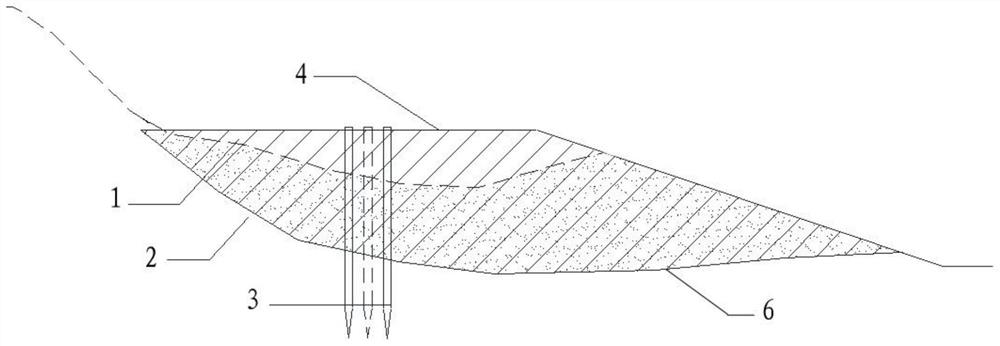A kind of reinforcement treatment method of bank protection foundation on soft stratum slope
A technology of foundation reinforcement and treatment method, which is applied in the field of reinforcement and treatment of bank revetment foundations in soft strata, can solve problems such as inability to be directly applied, poor water retention in collapse, and easy to be washed by heavy rains, and achieve strong site adaptability, small construction site occupation, and The effect of simple construction technology
- Summary
- Abstract
- Description
- Claims
- Application Information
AI Technical Summary
Problems solved by technology
Method used
Image
Examples
Embodiment 1
[0036] Such as figure 1 As shown, the method for strengthening the revetment foundation of the soft stratum slope comprises the following steps:
[0037] Step 1, clean up the soft ground layer:
[0038] Step 1.1, using static pressure to press the conical probe into the soil at a constant rate and at a constant speed, the sensor in the conical probe is input to the recorder in the form of electrical signals and recorded, and then converted into pressure through the calibration coefficient, and the change with depth is obtained. Pressure curve, and then divide the soil layer in the construction area according to the curve, and determine the depth and range of the soft soil layer;
[0039] Step 1.2: Excavate drainage ditches and water collection wells along the edge of the soft ground; the drainage ditch is 50cm wide and 60cm deep; the length, width and height of the water collection wells are 2m×2m×1.5m;
[0040] Step 1.3, laying steel plates on the track of the excavator, and ...
Embodiment 2
[0052] On the basis of Example 1, when aiming at the thicker slope foundation reinforcement treatment of silt, on the basis of Example 1, such as image 3 As shown, the method for strengthening the revetment foundation of the soft stratum slope comprises the following steps:
[0053] Step 1, clean up the soft ground layer:
[0054] Step 1.1, using static pressure to press the conical probe into the soil at a constant rate and at a constant speed, the sensor in the conical probe is input to the recorder in the form of electrical signals and recorded, and then converted into pressure through the calibration coefficient, and the change with depth is obtained. Pressure curve, and then divide the soil layer in the construction area according to the curve, and determine the depth and scope of the soft soil layer;
[0055] Step 1.2: Excavate drainage ditches and water collection wells along the edge of the soft ground; the width of the drainage ditch is 50cm, and the depth is 80cm; ...
PUM
 Login to View More
Login to View More Abstract
Description
Claims
Application Information
 Login to View More
Login to View More - R&D Engineer
- R&D Manager
- IP Professional
- Industry Leading Data Capabilities
- Powerful AI technology
- Patent DNA Extraction
Browse by: Latest US Patents, China's latest patents, Technical Efficacy Thesaurus, Application Domain, Technology Topic, Popular Technical Reports.
© 2024 PatSnap. All rights reserved.Legal|Privacy policy|Modern Slavery Act Transparency Statement|Sitemap|About US| Contact US: help@patsnap.com










